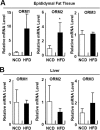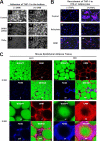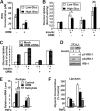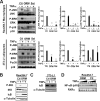Adipocytokine orosomucoid integrates inflammatory and metabolic signals to preserve energy homeostasis by resolving immoderate inflammation
- PMID: 20442402
- PMCID: PMC2903347
- DOI: 10.1074/jbc.M109.085464
Adipocytokine orosomucoid integrates inflammatory and metabolic signals to preserve energy homeostasis by resolving immoderate inflammation
Abstract
Orosomucoid (ORM), also called alpha-1 acid glycoprotein, is an abundant plasma protein that is an immunomodulator induced by stressful conditions such as infections. In this study, we reveal that Orm is induced selectively in the adipose tissue of obese mice to suppress excess inflammation that otherwise disturbs energy homeostasis. Adipose Orm levels were elevated by metabolic signals, including insulin, high glucose, and free fatty acid, as well as by the proinflammatory cytokine tumor necrosis factor-alpha, which is found in increased levels in the adipose tissue of morbid obese subjects. In both adipocytes and macrophages, ORM suppressed proinflammatory gene expression and pathways such as NF-kappaB and mitogen-activated protein kinase signalings and reactive oxygen species generation. Concomitantly, ORM relieved hyperglycemia-induced insulin resistance as well as tumor necrosis factor-alpha-mediated lipolysis in adipocytes. Accordingly, ORM improved glucose and insulin tolerance in obese and diabetic db/db mice. Taken together, our results suggest that ORM integrates inflammatory and metabolic signals to modulate immune responses to protect adipose tissue from excessive inflammation and thereby from metabolic dysfunction.
Figures









Similar articles
-
β-Sitosterol Circumvents Obesity Induced Inflammation and Insulin Resistance by down-Regulating IKKβ/NF-κB and JNK Signaling Pathway in Adipocytes of Type 2 Diabetic Rats.Molecules. 2021 Apr 6;26(7):2101. doi: 10.3390/molecules26072101. Molecules. 2021. PMID: 33917607 Free PMC article.
-
The adipokine orosomucoid alleviates adipose tissue fibrosis via the AMPK pathway.Acta Pharmacol Sin. 2022 Feb;43(2):367-375. doi: 10.1038/s41401-021-00666-9. Epub 2021 Apr 19. Acta Pharmacol Sin. 2022. PMID: 33875797 Free PMC article.
-
Orosomucoid serum concentrations and fat depot-specific mRNA and protein expression in humans.Mol Cells. 2012 Jan;33(1):35-41. doi: 10.1007/s10059-012-2181-9. Epub 2011 Nov 29. Mol Cells. 2012. PMID: 22134720 Free PMC article.
-
Adipocyte-Macrophage Cross-Talk in Obesity.Adv Exp Med Biol. 2017;960:327-343. doi: 10.1007/978-3-319-48382-5_14. Adv Exp Med Biol. 2017. PMID: 28585206 Review.
-
Insulin resistance induced by tumor necrosis factor-alpha in myocytes and brown adipocytes.J Anim Sci. 2008 Apr;86(14 Suppl):E94-104. doi: 10.2527/jas.2007-0462. Epub 2007 Oct 16. J Anim Sci. 2008. PMID: 17940160 Review.
Cited by
-
Orosomucoid 2 maintains hepatic lipid homeostasis through suppression of de novo lipogenesis.Nat Metab. 2022 Sep;4(9):1185-1201. doi: 10.1038/s42255-022-00627-4. Epub 2022 Sep 1. Nat Metab. 2022. PMID: 36050503
-
α1-Acid Glycoprotein and Dietary Intake in End-Stage Renal Disease Patients.Nutrients. 2021 Oct 20;13(11):3671. doi: 10.3390/nu13113671. Nutrients. 2021. PMID: 34835927 Free PMC article.
-
Proteomic quantitative study of dorsal root ganglia and sciatic nerve in type 2 diabetic mice.Mol Metab. 2022 Jan;55:101408. doi: 10.1016/j.molmet.2021.101408. Epub 2021 Nov 30. Mol Metab. 2022. PMID: 34856394 Free PMC article.
-
α(1)-Acid glycoprotein up-regulates CD163 via TLR4/CD14 protein pathway: possible protection against hemolysis-induced oxidative stress.J Biol Chem. 2012 Aug 31;287(36):30688-700. doi: 10.1074/jbc.M112.353771. Epub 2012 Jul 17. J Biol Chem. 2012. PMID: 22807450 Free PMC article.
-
Secreted proteins in treating metabolic dysfunction-associated steatotic liver disease: from bench towards bedside.Protein Cell. 2025 Aug 7;16(8):641-666. doi: 10.1093/procel/pwaf027. Protein Cell. 2025. PMID: 40243151 Free PMC article. Review.
References
-
- Hotamisligil G. S. (2006) Nature 444, 860–867 - PubMed
-
- Hotamisligil G. S., Shargill N. S., Spiegelman B. M. (1993) Science 259, 87–91 - PubMed
-
- Suganami T., Tanimoto-Koyama K., Nishida J., Itoh M., Yuan X., Mizuarai S., Kotani H., Yamaoka S., Miyake K., Aoe S., Kamei Y., Ogawa Y. (2007) Arterioscler. Thromb. Vasc. Biol. 27, 84–91 - PubMed
-
- Zhang H. H., Halbleib M., Ahmad F., Manganiello V. C., Greenberg A. S. (2002) Diabetes 51, 2929–2935 - PubMed
Publication types
MeSH terms
Substances
LinkOut - more resources
Full Text Sources
Molecular Biology Databases
Miscellaneous

